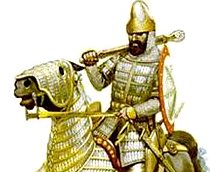
Battle of Singara |
year: 344 344 or 346 or 348 |
| A night battle with heavy losses for both sides | ★ ★ ★ ★ ★ |
|
enemy: Sassanid Persians
|
location: Near the Roman fort Singara, South-East of Nisibis, present-day Sinjar in northern Iraq
|
accuracy:
●●●●●
|
|
battle type: Night battle |
war: Later Roman-Persian Wars |
modern country:
Iraq |
| ▼ The Byzantines(emperor: Constantius II) | ▼ The Enemies | |
| Commander: | Emperor Constantius II | Shah Shapur II |
| Forces: | Unknown | Unknown |
| Losses: |
| Background story: |
| When Shapur II took control of the Sassanid Empire, he sought to regain old territories previously lost to the Eastern Roman Empire. He invaded Roman Mesopotamia and laid waste to the country. In 344, Shapur raised an army that included foot archers, mounted archers, regular cavalry, cataphracts, slingers, and hoplites and crossed the Tigris river in Roman territory. The Romans knew about his invasion and a Roman army waited for him near the borders under the command of Emperor Constantius II. |
The Battle: |
 Sassanid Persian horseman The battle was fierce and despite the fatigue, the Romans managed to repel the Persians taking advantage of their numerical advantage. Towards the end of the day, Shapur left his army, entrusting the command to his son Narseh. The Romans defeated the Persians on the battlefield and captured prince Narseh, who was tortured to death. As night fell, the Persians retreated to their fortified camp (which should not have been far from the battlefield). At that time the organised armies avoided the night battles and Constantius ordered the attack to stop. But his men disobeyed (there is even talk of mutiny from a source) and continued the attack (a key motivation for the soldiers had always been to loot the enemy camp). The Romans captured the camp easily, but made the mistake of using torches to see. Thus they became an easy target for the Persians who lurked nearby and who, protected by the darkness, began to shoot at them with arrows and spears and to make raids during the night. The Romans being disorganized, out of formation and exhausted, were unable to defend themselves effectively and suffered heavy losses. |
Aftermath: |
| The outcome of the battle (classified as a night battle) was probably a victory for the Persians, but they gained nothing substantial afterwards, and retreated into their own territory. Shapur returned to the area in the following years, tried to occupy Nisibis but failed. After a break of several years, the war resumed in 359 and the Persians were able to capture Singara in 360. |
|
|
